The names of early varieties of watermelons for open ground and reviews about them
Early varieties of watermelons for open ground should be resistant to climatic conditions, immune to diseases and pests. Such varieties are demanding on the condition of the soil - its composition and acidity. Seeds or seedlings are planted after processing and preparing the land: it is disinfected, dug up and fertilized.
In terms of taste and marketability, early ripening sugar watermelons are not inferior to medium or late varieties and hybrids. Consider the names of the earliest seeds of watermelon and their features further.
The content of the article
What are the features and benefits of early ripening varieties of watermelons
Early maturing varieties are suitable for growing in regions with short and cool summers. The ripening period is 2-3 months, the plants do not have time to get sick, the fruits are tied quickly and amicably. Seeds or seedlings are planted directly in the ground or under a film cover.
To get a rich harvest, gardeners observe the maintenance regime - they regularly water and fertilize the soil, loosen and weed the beds. For temperate climates, planting seedlings is more suitable - this provides protection against diseases and pests, stimulates the rapid development of plants.

Early open field watermelons
Consider the best early ripening varieties and hybrids of watermelon for open ground, find out their advantages and distinctive features.
Gift to the North F1
The hybrid ripens in 70-80 days, grow it in open or closed ground. The fruits are large, each weighing from 9 to 12 kg. The peel is thin, with a light green stripe. The pulp is sugar and juicy, with a rich raspberry color.
It is universal in use, watermelon jam and jams are made from the pulp, consumed fresh. The hybrid is resistant to diseases and pests, suitable for growing on an industrial scale.
Twinkle
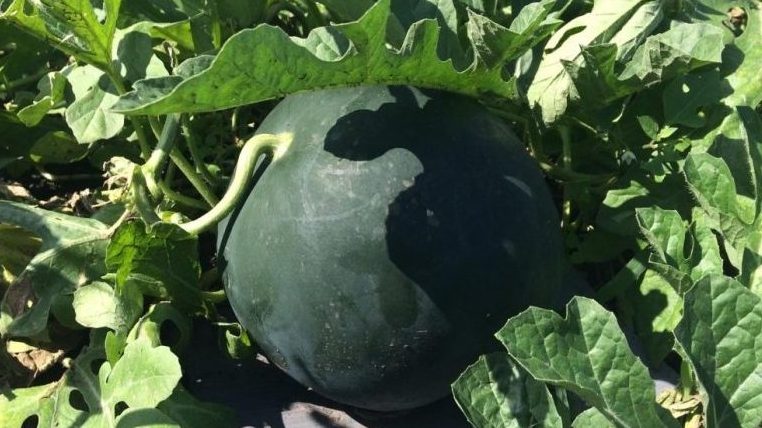
The variety is popular among gardeners in the Urals and Siberia. Matures Twinkle in 75 days, it is planted in seedlings. To obtain the highest yield, it is recommended to water the beds with an ash solution. Watermelons are small, weight 2-3 kg. The rind is dense, matte green. The pulp is sugary. About 4 kg of sweet watermelons are harvested from 1 m².
Interesting! Watermelon pulp contains natural alkalis, therefore it has an effective diuretic effect. Thanks to folic acid, watermelon has a beneficial effect on the intestinal microflora, stimulates digestion and metabolic processes.
Crimson Ruby F1
Gardeners collect the first fruits after 58-65 days. Grow Crimson Ruby in the southern regions of the country - the hybrid is picky about the composition of the soil, it is grown on loose and vitamin beds enriched with potassium and phosphorus.
The average fruit weight is 13 kg, the skin is dense, the crop is suitable for long-distance transportation. The pulp is sugary and sweet, pink, with white fibers.
Farao F1
The crop ripens in 86 days, Farao is planted in the open field. Plants are vigorous and branchy, spacious beds are suitable for planting. The hybrid is immune to melon aphids, rarely gets sick. The fruits are large, elongated, oval. Weight varies from 10 to 15 kg. The color is green with light stripes. The pulp is fiber-free, sweet and tasty.
Farao is grown for sale and for personal consumption.The hybrid is versatile in application.
Ataman F1
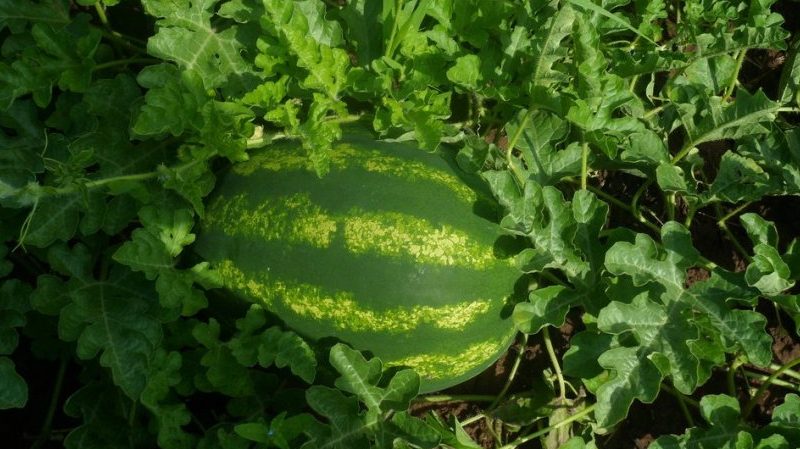
Ultra-ripe Ataman ripens in 55-65 days from the moment of seed germination. The bushes are medium in size, the leaves are dark green. One plant ripens about 4-6 fruits weighing 13-16 kg. The shape is oval, the peel is striped, green. The pulp is grainy, bright red, sweet and fleshy. The crop is suitable for long-term storage and transportation.
Top Gun F1
The ripening period is about 60 days. The hybrid is planted with seeds in open ground or seedlings are prepared. The plant is resistant to fusarium wilt and anthracnose. Oval shape, peel of medium thickness, dark green with light stripes. Fruit weight 9 kg, dark red pulp. The taste is sweet and sugary, the harvest is universal in application.
Sweet diamond
In the southern regions, Sweet Diamond is grown in the open field, in the northern and middle lane - in greenhouses or greenhouses. The crop ripens in 70 days, seedlings are used for planting. Plants are compact, average foliage. The shape of the watermelon is round, weight 4 kg. The pulp is tender and sweet, grainy, the seeds are dark brown.
Interesting! In the countries of the Middle East, flour and butter are made from watermelon seeds. The seeds are pre-washed and fried. They have 2 times more protein than almond or sunflower seeds. There are also amino acids that normalize blood pressure and have a beneficial effect on brain function.
Nice
The crop ripens in 65-75 days. The fruits are resistant to powdery mildew and tobacco mosaic virus. Watermelons are round, compact, weight of one is about 7 kg. Light green crust with wavy stripes. The pulp is raspberry, pleasant and sweet in taste. To obtain a rich harvest, the beds are watered with a solution of bird manure or droppings.
Sugar Lightning F1
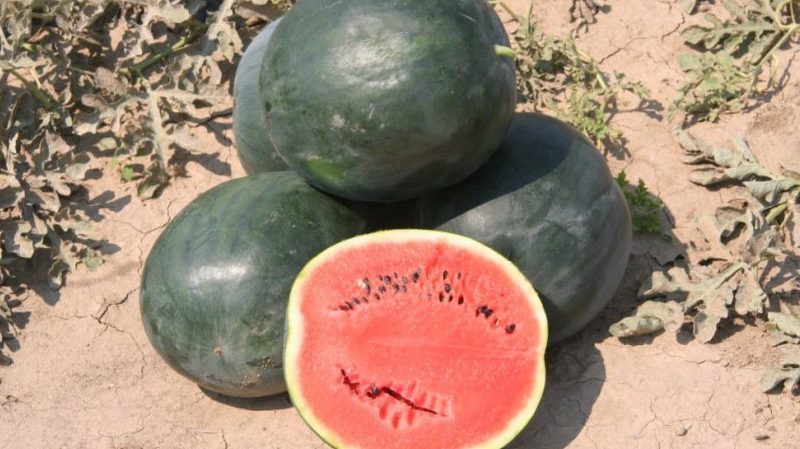
An ultra-early hybrid matures in 60 days. The plants are vigorous, with long shoots and a developed root system. The fruits are round, the peel is dark green, matte. Watermelon weight is about 3 kg. The pulp is grainy, honey-flavored, sweet. Sugar zipper is consumed fresh, the pulp looks beautiful in the form of fruit slices.
Skorik
Skorik ripens in 60-65 days from the moment the first shoots appear. The plant is powerful and climbing; spacious beds are chosen for planting. Fruits are oval, green with dark stripes, weight about 3 kg. The pulp is fibrous, deep red. The taste is sweet and juicy. The fruits are formed together, the fruiting period is extended.
Skorik is resistant to the main diseases of the crop, and is rarely attacked by insect pests.
Sluggard
Lezhebok ripens in 85 days, after harvesting the crop is stored for 3-4 months. The plant is medium in size, the leaves are compact. The rind is dense and firm, green with vague dark stripes. Fruits are spherical, weight 5-7 kg. The pulp is rich, red, tender and grainy, the taste is sweet.
Champagne Pink F1
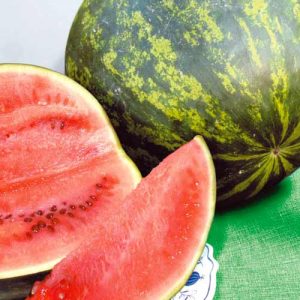
Hybrid Rose Champagne matures in 80 days. Fruit weight is about 7 kg, watermelon is distinguished by sweet granular pulp of rich pink color.
Watermelon is appreciated for its sweet taste and is especially well suited for fresh consumption. For longer storage, the crop is placed in a basement or cellar.
Grow Pink champagne under film shelters or in the open air.
Bonta F1
An ultra-early hybrid ripens in 58-65 days, depending on the growing region. Plants are branched, so gardeners allocate spacious beds for planting. The fruit is oval-round, light green color with dark stripes.
Bonta has an attractive presentation, therefore a hybrid is grown for sale. Fruit weight varies from 8 to 10 kg, the pulp is light red, sweet, few seeds. From 1 m² are harvested from 13 to 20 kg of a juicy crop.
Lunar
The original watermelon ripens in 70 days from the date of planting. It is famous for its unusual appearance - bright yellow pulp looks appetizing on a festive table in the form of fruit slices or salads.It tastes different from the traditional red - Moon watermelon has a sweet taste with refreshing hints of lemon.
The shape is round, the skin is green, the weight of the fruit is from 2 to 5 kg. The seeds are black, there are few of them.
Farmer Beijing Joy F1
An early ripe hybrid ripens in 70-80 days from the moment of planting. Differs in resistance to melon aphids and wireworm, rarely suffers from fusarium wilting. Fruits are round, medium in size, weight about 6 kg.
Plants are large, from one bush harvested from 15 to 25 kg. The fruits ripen together. The pulp is sweet, bright pink, the seeds are dark brown, rough. The hybrid is versatile in application.
Gift of the sun
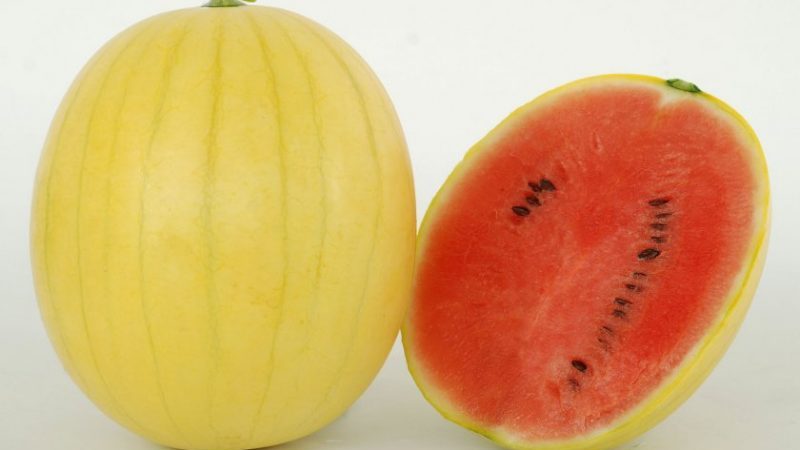
The growing season is 60-65 days, the super early ripening variety is grown in the open field or in a greenhouse, depending on the region. It is unpretentious in care, does not require special agrotechnical skills. The peel is yellow-golden, the flesh is orange.
The beautiful fruit looks like a pumpkin or melon. The mass of the watermelon is about 3 kg, the taste is sweet and delicate. The gift of the sun is suitable for growing in compact garden plots - the plants are miniature, but each ripens from 6 to 8 kg of harvest.
Interesting! The decorative variety is actively used for preparing interesting dishes. For example, a watermelon is cut into triangular slices, each of which is put on a wooden stick and put into the freezer for several hours. It turns out a natural "fruit ice".
Red Star F1
An early ripening hybrid ripens in 65-70 days. Gardeners use seed planting in open ground or seedling method. The plants are branched, the lashes are thick and powerful. The rind is dense, dark green, matte. Thanks to the thick crust, the crop is transported over long distances and sold.
The shape is spherical, the mass of the watermelon is about 7 kg. The pulp is red, grainy, universal in use.
Surprise F1
The hybrid ripens in 70 days. The pulp is yellow-orange, juicy, melon-watermelon taste. Fruit weight about 4 kg, pulp with a high sugar content. The harvest is stored for up to 3 months, retains its taste and marketability. Reviews about the watermelon Surprise are positive, it is appreciated for its unpretentiousness and resistance to disease.
Features of care and cultivation of early maturing varieties
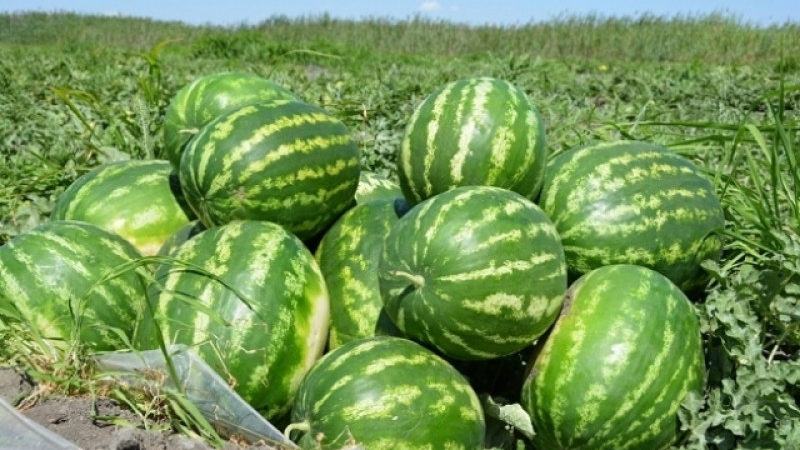
To obtain a rich harvest, gardeners use the seedling method of growing. It includes several stages:
- Seed preparation. For planting, use even and smooth seeds without external defects - cracks, spots, scratches. Seed material is disinfected with a weak solution of potassium permanganate and dried. Then sprout by wrapping in wet gauze. Disinfection and germination strengthen the immunity of seeds, protect them from diseases and pests.
- Soil preparation. For seedlings, they use land from the garden, having previously mixed it with ready-made bio-soil. The soil is watered with Bordeaux liquid and fertilized with liquid manure.
- Tank preparation. Gardeners use any convenient container - wooden boxes, flower pots, plastic cassettes with pallets. Before planting, it is washed with a soda solution.
After planting in the ground, the seedlings are watered with warm water and covered with polyethylene to protect them from possible frost and rain. Polyethylene is removed after 5-7 days, the soil is moistened again. In the future, watermelon is watered once a week, about 2 liters of water are consumed per bush. Fertilizers are applied every 15 days, using mineral and organic feeding: urea, manure, bird droppings, superphosphate, mineral complexes "Magic Leica" and "Zdraven".
Important! Early varieties need regular weeding and loosening. These treatments prevent pests and make the soil nutritious and light. Plants improve their metabolism, they receive more moisture and oxygen.
Requirements for the site and soil quality
Watermelons love nutritious and fertile soil. Gardeners choose light and spacious beds located on hilly areas for planting.Preparation begins in the fall: they dig up the earth, clean it of debris and last year's plants. After winter, the soil is dug up again, fertilized with liquid manure and sprinkled with wood ash. To impart friability, cleaned river sand or sawdust is introduced.
Important! If the soil is characterized by a high acid content, a lime solution is introduced into the beds before planting.
The best predecessors for watermelons are potatoes, carrots, and cabbage. Not recommended to be planted after pumpkin or melon.
Harvesting and storage
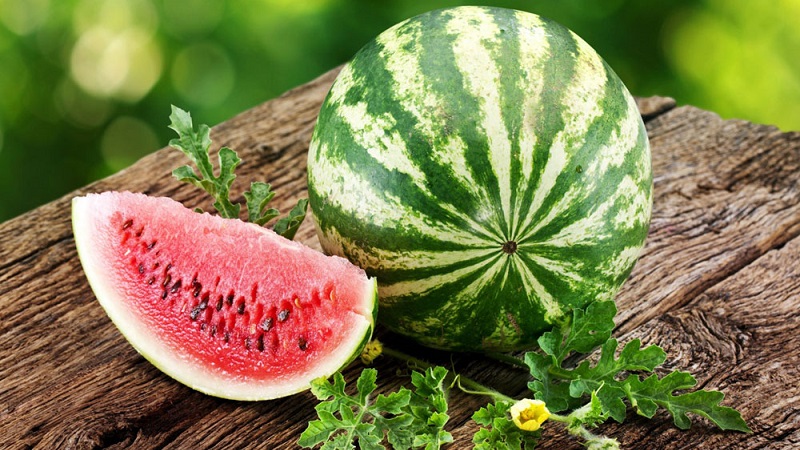
The ripeness of a watermelon is determined by a dull sound when tapped. The ripe fruit has a characteristic color, firm crust and dry stalk. For long-term storage after collecting, watermelons are not washed with water, they are placed in a dry basement in wooden boxes. Cover the top with newspapers or thin wooden lids.
Fruit with damage and a soft crust is recommended to be eaten immediately or processed - to prepare fruit snacks, salads, jellies or summer cocktails.
Reviews of early varieties
What do experienced farmers and gardeners say about the varietal characteristics of different watermelons? Consider a few comments and reviews.
Irina, Voronezh: «I love early ripening varieties of watermelons, in early August they are already juicy and sweet. I like Pink champagne - a fragrant and mouth-watering watermelon, easy to care for, excellent taste.
Ilya, Chelyabinsk: “The Skoryk variety is ideal for our region. I have grown it for the fifth year in a row. Skorik gives a stable yield, delicious watermelons. But Top-Gan let me down, got sick with fusarium. "
Maria, Novosibirsk: “I grow only early-maturing varieties on the site. I like Sweet Diamond. It has a very delicate flesh and a juicy taste. There are few seeds, we love to eat it fresh. "
Conclusion
Early maturing varieties are grown by gardeners throughout Russia - unpretentious and tasty watermelons take root in the southern and northern regions. The average ripening period is about 70 days, varieties and hybrids show stable yields.
Harvested in August: some are eaten immediately, others are harvested for long-term storage. Salads and snacks, smoothies and milkshakes are prepared from the sweet and tender pulp.